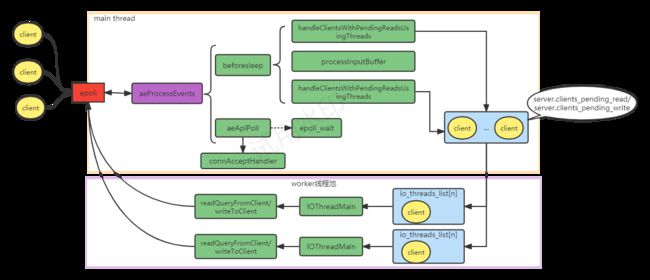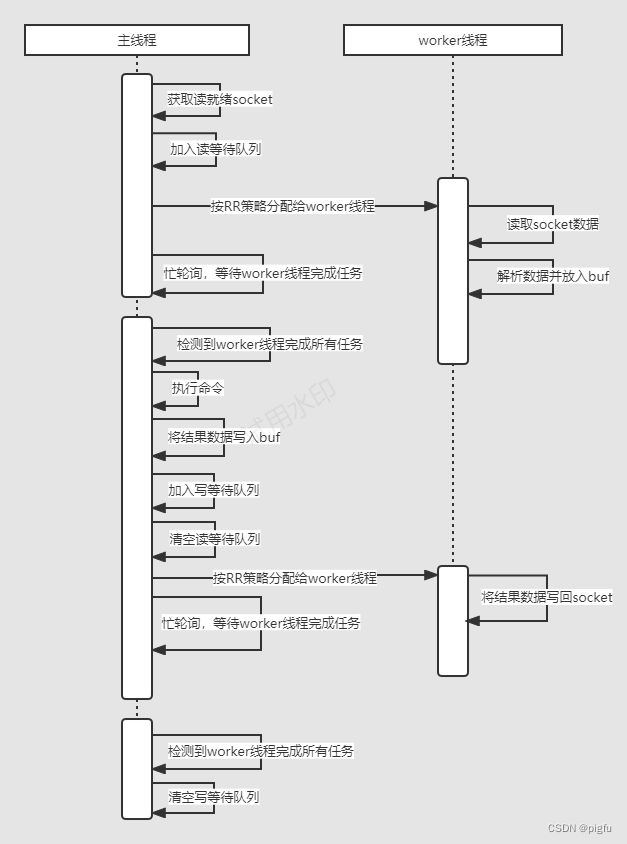Redis中的Reactor模型和执行命令源码探索
文章目录
- 摘要
-
-
- 1、 了解Linux的epoll
- 2、了解Reactor模型
-
- 一、Redis初始化
-
-
- 1.1、配置初始化
- 1.2、服务初始化
- 1.3、网络监听初始化
- 1.4、Reactor线程池初始化
- 1.5、Reactor事件主循环
-
- 二、Reactor
-
-
- 2.1、Reactor事件处理器
- 2.2、读事件
-
-
- 2.2.1、第一次读事件(accept)
- 2.2.2、第二次读事件(read)
-
- 2.3、读任务分配
- 2.4、读任务处理
- 2.5、命令执行
-
-
- 2.5.1、以get命令为例
- 2.5.2、执行命令
-
- 2.6、写任务分配
- 2.7、写回客户端
-
- 三、总结
-
-
- 3.1、Redis的Reactor模型
- 3.2、命令执行过程
-
摘要
有时候在面试的时候会被问到Redis为什么那么快?有一点就是客户端请求和应答是基于I/O多路复用(比如linux的epoll)的Reactor模型,今天我们就基于这个点顺着Redis的源码进行探索。
PS:本文基于Redis7.2.0源码
建议阅读本文之前熟悉Linux的epoll和Reactor模型相关知识
1、 了解Linux的epoll
在UNIX网络编程这本书中对socket有清晰的描述,server端的可用系统函数有socket、bind、listen、accept、read、write、close,其中accept、read、write依次是socket的接受完成三次握手的连接,读数据,写数据操作。
最基本的socket模型是阻塞模型,随着技术的演进,又有了非阻塞,I/O多路复用,信号驱动、异步五种I/O模型。其中I/O多路复用模型是用的最广的,而其在linux下又分为select,poll,epoll三种,性能依次提升,Redis在linux下的网络就是基于epoll的。
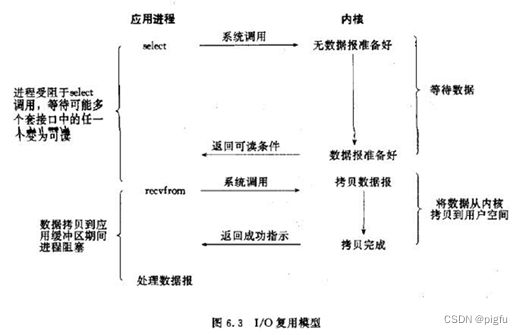
2、了解Reactor模型
Reactor模型在网络编程中非常有名,比如Java的Netty,优点是,相比多线(进)程在相同资源条件下可以同时处理更多的连接,核心就是对socket按事件类型(接受连接、读、写)进行拆分处理,令每个socket都有被执行的机会。Reactor模型分为单Reactor单线程、单Reactor多线程、多Reactor(一主多从)多线程三种类型,如下图:
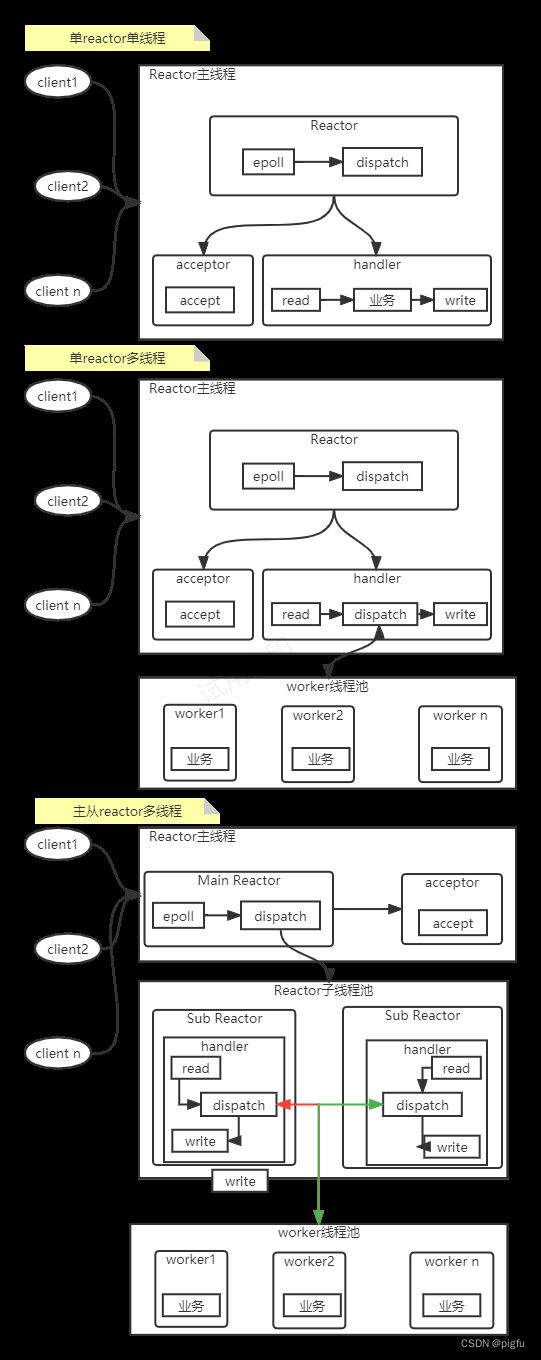
我们知道Redis在V6.0之前都是单Reactor单线程类型,那V6.0改造之后呢???,跟着下面的源码探索吧
一、Redis初始化
我们知道 c 语言入口函数一般都是 main 函数,所以我们先从入口函数下手,Redis server端的入口函数在server.c文件中。
int main(int argc, char **argv) {
//配置初始化,配置文件,redis命令注册之类的
initServerConfig();
//初始化服务,
initServer();
//初始化网络listen
initListeners();
//Some steps in server initialization need to be done last (after modules are loaded)
//特别是线程池的初始化
InitServerLast();
//开始主线程循环
aeMain(server.el);
aeDeleteEventLoop(server.el);
}
1.1、配置初始化
该函数主要是做配置初始化默认值和Redis命令注册
void initServerConfig(void) {
...
initConfigValues();
...
/* Command table -- we initialize it here as it is part of the
* initial configuration, since command names may be changed via
* redis.conf using the rename-command directive. */
server.commands = dictCreate(&commandTableDictType);
server.orig_commands = dictCreate(&commandTableDictType);
populateCommandTable();
...
}
- 命令注册,其中redisCommandTable变量 位于commands.c文件中,枚举了Redis命令,比如set、get。遍历redisCommandTable注册到server.commands
void populateCommandTable(void) {
int j;
struct redisCommand *c;
for (j = 0;; j++) {
c = redisCommandTable + j;
if (c->declared_name == NULL)//没有了
break;
int retval1, retval2;
c->fullname = sdsnew(c->declared_name);
if (populateCommandStructure(c) == C_ERR)
continue;
retval1 = dictAdd(server.commands, sdsdup(c->fullname), c);//命令注册
/* Populate an additional dictionary that will be unaffected by rename-command statements in redis.conf. */
retval2 = dictAdd(server.orig_commands, sdsdup(c->fullname), c);
serverAssert(retval1 == DICT_OK && retval2 == DICT_OK);
}
}
1.2、服务初始化
initServer时初始化服务起点。
void initServer(void) {
//初始化server这个全局变量
/* Initialization after setting defaults from the config system. */
server.aof_state = server.aof_enabled ? AOF_ON : AOF_OFF;
//基于配置文件配置的最大连接数创建事件循环器
server.el = aeCreateEventLoop(server.maxclients+CONFIG_FDSET_INCR);
server.clients_pending_write = listCreate();//全局写任务链表,用户分配给Reactor线程池
server.clients_pending_read = listCreate();//全局读任务链表
.....
//创建定时任务管理器(比如key过期,客户端超时等),并设置回调函数为serverCron
if (aeCreateTimeEvent(server.el, 1, serverCron, NULL, NULL) == AE_ERR) {
serverPanic("Can't create event loop timers.");
exit(1);
}
/* Register a readable event for the pipe used to awake the event loop
* from module threads. */
if (aeCreateFileEvent(server.el, server.module_pipe[0], AE_READABLE,
modulePipeReadable,NULL) == AE_ERR) {
serverPanic(
"Error registering the readable event for the module pipe.");
}
/* Register before and after sleep handlers (note this needs to be done
* before loading persistence since it is used by processEventsWhileBlocked. */
aeSetBeforeSleepProc(server.el,beforeSleep);
aeSetAfterSleepProc(server.el,afterSleep);
}
1.3、网络监听初始化
这里实现了socket的系统函数的scoket,bind,listen三步调用。
根据配置有三种选择TCP/TLS/Unix */,三者都实现了ConnectionType结构体的定义,位于connection.h文件中,在connection.c文件的connTypeInitialize函数会注册这三种类型(CT_Socket,CT_TLS,CT_Unix)
当在配置文件配置了port(比如6379)时,就选用CT_Socket。
void initListeners() {
/* Setup listeners from server config for TCP/TLS/Unix */
int conn_index;
connListener *listener;
if (server.port != 0) {//listen for TCP,
conn_index = connectionIndexByType(CONN_TYPE_SOCKET);
if (conn_index < 0)
serverPanic("Failed finding connection listener of %s", CONN_TYPE_SOCKET);
listener = &server.listeners[conn_index];
listener->bindaddr = server.bindaddr;//我们在配置文件配置bind关键字时,可以配置多个,因此是个数组
listener->bindaddr_count = server.bindaddr_count;
listener->port = server.port;
listener->ct = connectionByType(CONN_TYPE_SOCKET);//获取CT_Socket
}
......
/* create all the configured listener, and add handler to start to accept */
int listen_fds = 0;
for (int j = 0; j < CONN_TYPE_MAX; j++) {
listener = &server.listeners[j];
if (listener->ct == NULL)
continue;
if (connListen(listener) == C_ERR) {//该函数会调用CT_Socket的listen函数,最后完成scoket,bind,listen的系统调用,并设置为非阻塞I/O
//在CT_Socket下调用链路为connListen=>(socket.c文件)connSocketListen=>listenToPort=>anetTcpServer(完成
//scoket,bind,listen的系统调用) ,anetNonBlock(设置为非阻塞I/O)
serverLog(LL_WARNING, "Failed listening on port %u (%s), aborting.", listener->port, listener->ct->get_type(NULL));
exit(1);
}
if (createSocketAcceptHandler(listener, connAcceptHandler(listener->ct)) != C_OK)
serverPanic("Unrecoverable error creating %s listener accept handler.", listener->ct->get_type(NULL));
listen_fds += listener->count;
}
....
}
本函数将socket设置为可读状态,并绑定CT_Socket的accept_handler函数,即socket.c的connSocketAcceptHandler函数,用于处理客户端的连接建立
int createSocketAcceptHandler(connListener *sfd, aeFileProc *accept_handler) {
int j;
for (j = 0; j < sfd->count; j++) {
if (aeCreateFileEvent(server.el, sfd->fd[j], AE_READABLE, accept_handler,sfd) == AE_ERR) {
/* Rollback */
for (j = j-1; j >= 0; j--) aeDeleteFileEvent(server.el, sfd->fd[j], AE_READABLE);
return C_ERR;
}
}
return C_OK;
}
1.4、Reactor线程池初始化
这里主要看一下Reactor线程池的初始化,要想启动线程池,需要最好参数配置:
io-threads n #worker线程个数
io-threads-do-reads yes #worker线程是否做read任务
void InitServerLast() {
bioInit();
initThreadedIO();
set_jemalloc_bg_thread(server.jemalloc_bg_thread);
server.initial_memory_usage = zmalloc_used_memory();
}
//线程池初始化
void initThreadedIO(void) {
...
for (int i = 0; i < server.io_threads_num; i++) {
/* Things we do for all the threads including the main thread. */
io_threads_list[i] = listCreate();//
if (i == 0) continue;// i=0是位置留给主线程,所以跳过
/* Things we do only for the additional threads. */
pthread_t tid;
pthread_mutex_init(&io_threads_mutex[i],NULL);
setIOPendingCount(i, 0);
pthread_mutex_lock(&io_threads_mutex[i]); /* Thread will be stopped. */
if (pthread_create(&tid,NULL,IOThreadMain,(void*)(long)i) != 0) {
serverLog(LL_WARNING,"Fatal: Can't initialize IO thread.");
exit(1);
}
io_threads[i] = tid;
}
}
线程执行函数IOThreadMain,其主要就是调用 readQueryFromClient处理读任务,调用writeToClient处理写任务
void *IOThreadMain(void *myid) {
while(1) {
for (int j = 0; j < 1000000; j++) {//循环1000000次,去等待I/O事件
if (getIOPendingCount(id) != 0) break;
}
/* Give the main thread a chance to stop this thread. */
if (getIOPendingCount(id) == 0) {//如果主线程已获取了当前线程锁,就会进入等待状态,直至被主线程解锁唤醒,否则继续循环1000000次去
pthread_mutex_lock(&io_threads_mutex[id]);
pthread_mutex_unlock(&io_threads_mutex[id]);
continue;
}
serverAssert(getIOPendingCount(id) != 0);
listRewind(io_threads_list[id],&li);
while((ln = listNext(&li))) {
client *c = listNodeValue(ln);
if (io_threads_op == IO_THREADS_OP_WRITE) {//写
writeToClient(c,0);
} else if (io_threads_op == IO_THREADS_OP_READ) {//读
readQueryFromClient(c->conn);
} else {
serverPanic("io_threads_op value is unknown");
}
}
listEmpty(io_threads_list[id]);
setIOPendingCount(id, 0);
}
}
1.5、Reactor事件主循环
本函数用于进入主线程事件循环逻辑
void aeMain(aeEventLoop *eventLoop) {
eventLoop->stop = 0;
while (!eventLoop->stop) {
aeProcessEvents(eventLoop, AE_ALL_EVENTS|
AE_CALL_BEFORE_SLEEP|
AE_CALL_AFTER_SLEEP);
}
}
本章中很多ae开头的函数,比如aeMain、aeCreateFileEvent、aeProcessEvents等,这些函数位于ae.c文件,是Redis事件管理器的具体实现,具体见下一章。
二、Reactor
在上一章中知道了通过aeMain开启了事件循环,那么先看一下aeProcessEvents函数。
在聊aeProcessEvents函数之前我们先看下Redis如何根据系统选择操作系统提供的I/O库的。
在ae.c文件开头可以看到如下代码:
/* Include the best multiplexing layer supported by this system.
* The following should be ordered by performances, descending. */
#ifdef HAVE_EVPORT
#include "ae_evport.c"
#else
#ifdef HAVE_EPOLL
#include "ae_epoll.c" //linux下选择epoll
#else
#ifdef HAVE_KQUEUE
#include "ae_kqueue.c"
#else
#include "ae_select.c"
#endif
#endif
#endif
2.1、Reactor事件处理器
Reactor事件处理位于ae.c文件,是一个对不同系统网络库(linux的select,epoll 。mac的kqueue)的抽象管理层,主要函数如下:
aeCreateEventLoop #创建aeEventLoop对象
aeMain #启动时事件循环
aeProcessEvents #事件循环处理逻辑
aeCreateFileEvent #创建网络IO事件
aeCreateTimeEvent #创建定时任务事件
当然还有很多,就不一一列举了,在ae.c文件中
就那比较核心的aeProcessEvents 函数看一下吧
int aeProcessEvents(aeEventLoop *eventLoop, int flags)
{
...
//执行initServer函数中注册的beforesleep回调函数
if (eventLoop->beforesleep != NULL && flags & AE_CALL_BEFORE_SLEEP)
eventLoop->beforesleep(eventLoop);
/* Call the multiplexing API, will return only on timeout or when
* some event fires. */
numevents = aeApiPoll(eventLoop, tvp);//获取socket事件,如果是epoll则是执行epoll_wait获取有事件的socket
/* Don't process file events if not requested. */
if (!(flags & AE_FILE_EVENTS)) {
numevents = 0;
}
//执行initServer函数中注册的aftersleep 回调函数
if (eventLoop->aftersleep != NULL && flags & AE_CALL_AFTER_SLEEP)
eventLoop->aftersleep(eventLoop);
...
for (j = 0; j < numevents; j++) {
//读事件
//在上一章的createSocketAcceptHandler已经了解到socket listen后第一次绑定了socket.c的connSocketAcceptHandler
//那么如果是accept事件就会调用connSocketAcceptHandler,继而调用networking.c的createClient
if (!invert && fe->mask & mask & AE_READABLE) {
fe->rfileProc(eventLoop,fd,fe->clientData,mask);
fired++;
fe = &eventLoop->events[fd]; /* Refresh in case of resize. */
}
//写事件
if (fe->mask & mask & AE_WRITABLE) {
if (!fired || fe->wfileProc != fe->rfileProc) {
fe->wfileProc(eventLoop,fd,fe->clientData,mask);
fired++;
}
}
/* If we have to invert the call, fire the readable event now after the writable one. */
if (invert) {
fe = &eventLoop->events[fd]; /* Refresh in case of resize. */
if ((fe->mask & mask & AE_READABLE) && (!fired || fe->wfileProc != fe->rfileProc))
{
fe->rfileProc(eventLoop,fd,fe->clientData,mask);
fired++;
}
}
}
}
2.2、读事件
在了解读事件前先看下连接管理对象和客户端管理对象
//连接管理对象
struct connection {
ConnectionType *type;
ConnectionState state;
short int flags;
short int refs;
int last_errno;
void *private_data;
ConnectionCallbackFunc conn_handler;
ConnectionCallbackFunc write_handler;
ConnectionCallbackFunc read_handler;
int fd;
};
//客户端管理对象
typedef struct client {
...
connection *conn; //连接
sds querybuf; /* Buffer we use to accumulate client querieske 每个客户端的读缓冲区*/
/*每个客户端写缓冲区相关变量 */
list *reply; /* List of reply objects to send to the client. 要写到客户端的数据,数据量比较大用这个,否则用buf*/
/* Response buffer */
size_t buf_peak; /* Peak used size of buffer in last 5 sec interval. */
mstime_t buf_peak_last_reset_time; /* keeps the last time the buffer peak value was reset */
int bufpos;
size_t buf_usable_size; /* Usable size of buffer. */
char *buf;
...
}
2.2.1、第一次读事件(accept)
- socket的accept和read都是读事件。所以在CT_Socket下,客户端第一次建立连接时先调用socket.c的connSocketAcceptHandler
进行accept系统函数调用,所以这第一次读事件就是连接应答,即接收客户到的连接并进行相应的处理
static void connSocketAcceptHandler(aeEventLoop *el, int fd, void *privdata, int mask) {
int cport, cfd, max = MAX_ACCEPTS_PER_CALL;
char cip[NET_IP_STR_LEN];
UNUSED(el);
UNUSED(mask);
UNUSED(privdata);
while(max--) {
cfd = anetTcpAccept(server.neterr, fd, cip, sizeof(cip), &cport);//调用系统函数accept,并设置socket为非阻塞的
if (cfd == ANET_ERR) {
if (errno != EWOULDBLOCK)
serverLog(LL_WARNING,"Accepting client connection: %s", server.neterr);
return;
}
serverLog(LL_VERBOSE,"Accepted %s:%d", cip, cport);
acceptCommonHandler(connCreateAcceptedSocket(cfd, NULL),0,cip);//connCreateAcceptedSocket函数创建conn对象并返回conn对象
}
}
//在networking.c文件
void acceptCommonHandler(connection *conn, int flags, char *ip) {
...
/* Create connection and client */
if ((c = createClient(conn)) == NULL) {//基于连接conn创建客户端管理对象
char addr[NET_ADDR_STR_LEN] = {0};
char laddr[NET_ADDR_STR_LEN] = {0};
connFormatAddr(conn, addr, sizeof(addr), 1);
connFormatAddr(conn, laddr, sizeof(addr), 0);
serverLog(LL_WARNING,"Error registering fd event for the new client connection: %s (addr=%s laddr=%s)",
connGetLastError(conn), addr, laddr);
connClose(conn); /* May be already closed, just ignore errors */
return;
}
...
}
- 创建client对象,并通过调用CT_Socket的set_read_handler函数(connSocketSetReadHandler)将conn的read_handler设置为readQueryFromClient函数,通过aeCreateFileEvent将fe的读回调函数设为CT_Socket的ae_handler函数,等待下次读事件调用。至此第一次读事件(accept)处理就结束了
client *createClient(connection *conn) {
client *c = zmalloc(sizeof(client));//创建client对象
...
if (conn) {
connEnableTcpNoDelay(conn);
if (server.tcpkeepalive)
connKeepAlive(conn,server.tcpkeepalive);
connSetReadHandler(conn, readQueryFromClient);//重点。调用CT_Socket的set_read_handler函数,就socket.c文件的connSocketSetReadHandler
connSetPrivateData(conn, c);
}
...
c->conn = conn;//赋值
if (conn) linkClient(c);//将该client对象加入client全局管理链表,即server.clients
return c;
}
static int connSocketSetReadHandler(connection *conn, ConnectionCallbackFunc func) {
if (func == conn->read_handler) return C_OK;
conn->read_handler = func;//设置conn的read_handler回调函数为readQueryFromClient
if (!conn->read_handler)
aeDeleteFileEvent(server.el,conn->fd,AE_READABLE);
else
//创建AE_READABLE事件,并绑定读回调函数为CT_Socket的ae_handler函数,等待aeProcessEvents循环触发进行回调
if (aeCreateFileEvent(server.el,conn->fd, AE_READABLE,conn->type->ae_handler,conn) == AE_ERR)
return C_ERR;
return C_OK;
}
2.2.2、第二次读事件(read)
对于一个客户端,在上一小节,看到了最后创建了一个读事件,并绑定读回调函数为CT_Socket的ae_handler函数,那么下一次主线程循环调用aeProcessEvents,就会调用ae_handler函数。下面看看ae_handler函数,即scoket.c文件的connSocketEventHandler干了什么。
ps:Redis客户端一般是长连接,经过第一次读事件(accept)后,第二~N次读事件都是read,直至某一方close。
static void connSocketEventHandler(struct aeEventLoop *el, int fd, void *clientData, int mask)
{
......
int invert = conn->flags & CONN_FLAG_WRITE_BARRIER;
int call_write = (mask & AE_WRITABLE) && conn->write_handler;
int call_read = (mask & AE_READABLE) && conn->read_handler;
/* Handle normal I/O flows */
if (!invert && call_read) {
if (!callHandler(conn, conn->read_handler)) return;//可以看到会调conn->read_handler函数,即上一节connSocketSetReadHandler中绑定的readQueryFromClient
}
/* Fire the writable event. */
if (call_write) {
if (!callHandler(conn, conn->write_handler)) return;
}
/* If we have to invert the call, fire the readable event now
* after the writable one. */
if (invert && call_read) {
if (!callHandler(conn, conn->read_handler)) return;
}
}
- 读取数据
readQueryFromClient 函数就是读取客户端数据并解析得到要执行的命令,这个函数是很核心的,我们逐步分析下
void readQueryFromClient(connection *conn) {
client *c = connGetPrivateData(conn);
int nread, big_arg = 0;
size_t qblen, readlen;
//如果开启了线程池,主线程不处理直接返回,等待在事件轮询时分配给worker线程池
if (postponeClientRead(c)) return;
/* Update total number of reads on server */
atomicIncr(server.stat_total_reads_processed, 1);//原子性的+1
...//省略代码
nread = connRead(c->conn, c->querybuf+qblen, readlen);//调用系统函数read读取socket数据,并放到当前client对象querybuf缓冲区,这时一个sds(简单动态字符串)类型
...//省略代码
if (processInputBuffer(c) == C_ERR)//解析数据得到命令并执行,该函数细节后续分析,这里知道作用就好了
c = NULL;
done:
beforeNextClient(c);
}
//
int postponeClientRead(client *c) {
if (server.io_threads_active && //线程池激活状态
server.io_threads_do_reads &&//配置允许线程池处理read任务
!ProcessingEventsWhileBlocked &&
!(c->flags & (CLIENT_MASTER|CLIENT_SLAVE|CLIENT_BLOCKED)) &&
io_threads_op == IO_THREADS_OP_IDLE)//线程池空闲状态
{
listAddNodeHead(server.clients_pending_read,c);//将当前client对象加入到全局等待读取的链表中,等待主线程分配
c->pending_read_list_node = listFirst(server.clients_pending_read);
return 1;
} else {
return 0;
}
}
2.3、读任务分配
上面小节的任务一直是主线程在做,可以看到在开启线程池的情况下,读任务只是插入到全局等待读链表server.clients_pending_read的头部,下面咱们就看看这些读任务是如何分配的吧。
细心的读者可能还记得在第一章第2节服务初始化源代码末尾注册的两个sleep函数
aeSetBeforeSleepProc(server.el,beforeSleep);
aeSetAfterSleepProc(server.el,afterSleep);
在第二章第1节Reactor网络事件处理中,源代码中就会调用两个sleep函数,如下:
int aeProcessEvents(aeEventLoop *eventLoop, int flags)
{
...
if (eventLoop->beforesleep != NULL && flags & AE_CALL_BEFORE_SLEEP)
eventLoop->beforesleep(eventLoop);
...//省略代码
if (eventLoop->aftersleep != NULL && flags & AE_CALL_AFTER_SLEEP)
eventLoop->aftersleep(eventLoop);
...
}
没错,分配工作就在beforeSleep函数中处理的:
void beforeSleep(struct aeEventLoop *eventLoop) {
...
if (ProcessingEventsWhileBlocked) {
uint64_t processed = 0;
processed += handleClientsWithPendingReadsUsingThreads();//处理server.clients_pending_read中的读任务
processed += connTypeProcessPendingData();
if (server.aof_state == AOF_ON || server.aof_state == AOF_WAIT_REWRITE)
flushAppendOnlyFile(0);
processed += handleClientsWithPendingWrites();//处理server.clients_pending_write中的写任务
processed += freeClientsInAsyncFreeQueue();
server.events_processed_while_blocked += processed;
return;
}
...
}
在这里你可以看到多线程下Redis只是把从socket读取数据和解析命令交给线程池处理,真正的执行命令依然由主线程进行处理
int handleClientsWithPendingReadsUsingThreads(void) {
if (!server.io_threads_active || !server.io_threads_do_reads) return 0;
int processed = listLength(server.clients_pending_read);
if (processed == 0) return 0;
// 遍历待读取的 client 队列 clients_pending_read,
// 通过 RR 轮询均匀地分配给 I/O 线程和主线程自己(编号 0)。
listIter li;
listNode *ln;
listRewind(server.clients_pending_read,&li);
int item_id = 0;
while((ln = listNext(&li))) {
client *c = listNodeValue(ln);
int target_id = item_id % server.io_threads_num;
listAddNodeTail(io_threads_list[target_id],c);
item_id++;
}
// 设置当前 I/O 状态为读取,给线程池中每个线程的计数器设置分配的任务数量,
// 让 线程池可以开始工作:只读取和解析命令,不执行。
io_threads_op = IO_THREADS_OP_READ;
for (int j = 1; j < server.io_threads_num; j++) {
int count = listLength(io_threads_list[j]);
setIOPendingCount(j, count);
}
// 主线程自己也会去执行读取客户端数据,再解析,最后执行请求命令的任务,以达到最大限度利用 CPU。
//此时io_threads_op为IO_THREADS_OP_READ,可以避开第2.2.2节postponeClientRead函数的check
listRewind(io_threads_list[0],&li);
while((ln = listNext(&li))) {
client *c = listNodeValue(ln);
readQueryFromClient(c->conn);
}
listEmpty(io_threads_list[0]);
// 主线程进入忙轮询,累加线程池中每个线程的原子任务计数器,直到所有计数器的遗留任务数量都是 0,才结束忙轮询。
while(1) {
unsigned long pending = 0;
for (int j = 1; j < server.io_threads_num; j++)
pending += io_threads_pending[j];
if (pending == 0) break;
}
//线程池任务处理完,设置当前 I/O 状态为空闲
io_threads_op = IO_THREADS_OP_IDLE;
// 遍历待读取的 client 队列,清除 CLIENT_PENDING_READ 和 CLIENT_PENDING_COMMAND 标记, 然后解析并执行所有 client 的命令。
while(listLength(server.clients_pending_read)) {
ln = listFirst(server.clients_pending_read);
client *c = listNodeValue(ln);
listDelNode(server.clients_pending_read,ln);
c->pending_read_list_node = NULL;
serverAssert(!(c->flags & CLIENT_BLOCKED));
if (beforeNextClient(c) == C_ERR) {//无效client跳过
/* If the client is no longer valid, we avoid processing the client later. So we just goto the next. */
continue;
}
/* Once io-threads are idle we can update the client in the mem usage */
updateClientMemUsageAndBucket(c);
if (processPendingCommandAndInputBuffer(c) == C_ERR) {//执行命令
/* If the client is no longer valid, we avoid processing the client later. So we just go to the next. */
continue;
}
/* We may have pending replies if a thread readQueryFromClient() produced replies and did not put the client in pending write queue (it can't)*/
if (!(c->flags & CLIENT_PENDING_WRITE) && clientHasPendingReplies(c))
putClientInPendingWriteQueue(c);
}
/* Update processed count on server */
server.stat_io_reads_processed += processed;
return processed;
}
int processPendingCommandAndInputBuffer(client *c) {
//如果有CLIENT_PENDING_COMMAND 标记,直接执行命令,这种因为已经由worker线程将数据解析好了
if (c->flags & CLIENT_PENDING_COMMAND) {
c->flags &= ~CLIENT_PENDING_COMMAND;//清除CLIENT_PENDING_COMMAND 标记
if (processCommandAndResetClient(c) == C_ERR) {
return C_ERR;
}
}
//client对象还有剩余的数据
if (c->querybuf && sdslen(c->querybuf) > 0) {
return processInputBuffer(c); //解析数据并执行命令,下一小节会有详细分析
}
return C_OK;
}
2.4、读任务处理
上一节看到读任务分配了,分配之后就要处理了,那在哪里处理呢?
细心的读者应该还记得第一章第4节Reactor线程池初始化中的线程执行函数IOThreadMain,其核心就是调用
readQueryFromClient处理读任务,调用writeToClient处理写任务。
看到readQueryFromClient函数,发现又回到【本章第2节读事件】了,该函数最后会调用一个processInputBuffer函数,下面来看一看吧。
该函数主要作用就是通过processInlineBuffer和processMultibulkBuffer解析命令,解析之后如果是worker线程在执行就退出,如果是主线程就会调processCommandAndResetClient执行命令
int processInputBuffer(client *c) {
while(c->qb_pos < sdslen(c->querybuf)) {
...//省略代码
if (c->reqtype == PROTO_REQ_INLINE) {
if (processInlineBuffer(c) != C_OK) break;//解析数据
} else if (c->reqtype == PROTO_REQ_MULTIBULK) {
if (processMultibulkBuffer(c) != C_OK) break;//解析数据
} else {
serverPanic("Unknown request type");
}
/* Multibulk processing could see a <= 0 length. */
if (c->argc == 0) {
resetClient(c);
} else {
/* If we are in the context of an I/O thread, we can't really
* execute the command here. All we can do is to flag the client
* as one that needs to process the command. */
if (io_threads_op != IO_THREADS_OP_IDLE) {//如果是worker线程在执行,就直接结束循环
serverAssert(io_threads_op == IO_THREADS_OP_READ);
c->flags |= CLIENT_PENDING_COMMAND;
break;
}
//根据前面解析的数据得到命令并执行命令
if (processCommandAndResetClient(c) == C_ERR) {
/* If the client is no longer valid, we avoid exiting this
* loop and trimming the client buffer later. So we return
* ASAP in that case. */
return C_ERR;
}
}
}
...//省略代码
}
2.5、命令执行
如果是主线程调用processInputBuffer函数就会走到processCommandAndResetClient去执行命令,该函数再调用processCommand函数。
注意:该函数一定是在主线程下执行的
细心的读者应该还记得第一章第1节配置初始化中Redis在全局变量server.command中,那么我们先看一下get命令吧
2.5.1、以get命令为例
先看一下redisCommandTable变量。
struct redisCommand {
...
redisCommandProc *proc; /* 回调函数 */
...
}
struct redisCommand redisCommandTable[] = {
...
{"get","Get the value of a key","O(1)","1.0.0",CMD_DOC_NONE,NULL,NULL,COMMAND_GROUP_STRING,GET_History,GET_tips,getCommand,2,CMD_READONLY|CMD_FAST,ACL_CATEGORY_STRING,{{NULL,CMD_KEY_RO|CMD_KEY_ACCESS,KSPEC_BS_INDEX,.bs.index={1},KSPEC_FK_RANGE,.fk.range={0,1,0}}},.args=GET_Args},
...
}
参数很多,但我们只看执行命令的回调函数getCommand就可以了,在t_strings.c文件中
void getCommand(client *c) {
getGenericCommand(c);
}
int getGenericCommand(client *c) {
robj *o;
if ((o = lookupKeyReadOrReply(c,c->argv[1],shared.null[c->resp])) == NULL)//获取数据
return C_OK;
if (checkType(c,o,OBJ_STRING)) {
return C_ERR;
}
addReplyBulk(c,o);//将获取的数据响应给客户端
return C_OK;
}
那如何将获取的数据响应给客户端呢?
/* Add a Redis Object as a bulk reply */
void addReplyBulk(client *c, robj *obj) {
addReplyBulkLen(c,obj);//添加数据长度到client对象的写缓冲区变量,写缓冲区变量见【本章第2节读事件】
addReply(c,obj);//添加数据到client的reply链表和buf缓冲区
addReplyProto(c,"\r\n",2);//添加数据结束标志到client对象的写缓冲区变量
}
/* Add the object 'obj' string representation to the client output buffer. */
void addReply(client *c, robj *obj) {
if (prepareClientToWrite(c) != C_OK) return;
//将本次的响应内容添加到client的reply链表和buf缓冲区,等待写回客户端
if (sdsEncodedObject(obj)) {
_addReplyToBufferOrList(c,obj->ptr,sdslen(obj->ptr));
} else if (obj->encoding == OBJ_ENCODING_INT) {
/* For integer encoded strings we just convert it into a string
* using our optimized function, and attach the resulting string
* to the output buffer. */
char buf[32];
size_t len = ll2string(buf,sizeof(buf),(long)obj->ptr);
_addReplyToBufferOrList(c,buf,len);
} else {
serverPanic("Wrong obj->encoding in addReply()");
}
}
int prepareClientToWrite(client *c) {
...
if (!clientHasPendingReplies(c) && io_threads_op == IO_THREADS_OP_IDLE)
putClientInPendingWriteQueue(c);//
...
}
可以看到最后将client对象添加到server.clients_pending_write等待写链表上,和等待写链表一样,等主线程将其分配给worker线程。
void putClientInPendingWriteQueue(client *c) {
/* Schedule the client to write the output buffers to the socket only
* if not already done and, for slaves, if the slave can actually receive
* writes at this stage. */
if (!(c->flags & CLIENT_PENDING_WRITE) &&
(c->replstate == REPL_STATE_NONE ||
(c->replstate == SLAVE_STATE_ONLINE && !c->repl_start_cmd_stream_on_ack)))
{
c->flags |= CLIENT_PENDING_WRITE;
listLinkNodeHead(server.clients_pending_write, &c->clients_pending_write_node);
}
}
2.5.2、执行命令
int processCommandAndResetClient(client *c) {
int deadclient = 0;
client *old_client = server.current_client;
server.current_client = c;
if (processCommand(c) == C_OK) {
commandProcessed(c);
/* Update the client's memory to include output buffer growth following the processed command. */
updateClientMemUsageAndBucket(c);
}
if (server.current_client == NULL) deadclient = 1;
server.current_client = old_client;
return deadclient ? C_ERR : C_OK;
}
int processCommand(client *c) {
if (!client_reprocessing_command) {
c->cmd = c->lastcmd = c->realcmd = lookupCommand(c->argv,c->argc);//到server.commands全局变量中查找命令
....
}
/* Exec the command */
if (c->flags & CLIENT_MULTI &&
c->cmd->proc != execCommand &&
c->cmd->proc != discardCommand &&
c->cmd->proc != multiCommand &&
c->cmd->proc != watchCommand &&
c->cmd->proc != quitCommand &&
c->cmd->proc != resetCommand)
{
queueMultiCommand(c, cmd_flags);
addReply(c,shared.queued);
} else {
int flags = CMD_CALL_FULL;
if (client_reprocessing_command) flags |= CMD_CALL_REPROCESSING;
call(c,flags);//调用查找到的命令
if (listLength(server.ready_keys))
handleClientsBlockedOnKeys();
}
return C_OK;
}
void call(client *c, int flags) {
//省略代码
c->cmd->proc(c);
}
可以看到如果客户端发了get命令,那么call本质就去执行getCommand函数,获取执行结果后添加到client的写缓冲区,最后将client对象添加到server.clients_pending_write待写链表中
2.6、写任务分配
在【本章第3节读任务分配】中,beforeSleep函数在分配完读任务后,接着就分配写任务了,即调用handleClientsWithPendingWritesUsingThreads函数。
int handleClientsWithPendingWritesUsingThreads(void) {
int processed = listLength(server.clients_pending_write);
if (processed == 0) return 0; /* Return ASAP if there are no clients. */
//没开启线程池或等待处理的写任务数量较少,就只有主线程处理
if (server.io_threads_num == 1 || stopThreadedIOIfNeeded()) {
return handleClientsWithPendingWrites();
}
/* Start threads if needed. */
if (!server.io_threads_active) startThreadedIO();
/* Distribute the clients across N different lists. */
listIter li;
listNode *ln;
listRewind(server.clients_pending_write,&li);
int item_id = 0;
while((ln = listNext(&li))) {
client *c = listNodeValue(ln);
c->flags &= ~CLIENT_PENDING_WRITE;
/* Remove clients from the list of pending writes since
* they are going to be closed ASAP. */
if (c->flags & CLIENT_CLOSE_ASAP) {
listUnlinkNode(server.clients_pending_write, ln);
continue;
}
/* Since all replicas and replication backlog use global replication
* buffer, to guarantee data accessing thread safe, we must put all
* replicas client into io_threads_list[0] i.e. main thread handles
* sending the output buffer of all replicas. */
if (getClientType(c) == CLIENT_TYPE_SLAVE) {//如果是slave发来的命令,只分配给主线程
listAddNodeTail(io_threads_list[0],c);
continue;
}
int target_id = item_id % server.io_threads_num;//RR分配策略
listAddNodeTail(io_threads_list[target_id],c);
item_id++;
}
//设置每个worker线程的任务数量,以唤醒worker线程工作
io_threads_op = IO_THREADS_OP_WRITE;
for (int j = 1; j < server.io_threads_num; j++) {
int count = listLength(io_threads_list[j]);
setIOPendingCount(j, count);
}
// 主线程自己也会去执行写数据到客户端的任务,以达到最大限度利用 CPU。
listRewind(io_threads_list[0],&li);
while((ln = listNext(&li))) {
client *c = listNodeValue(ln);
writeToClient(c,0);
}
listEmpty(io_threads_list[0]);
//主线程进入忙轮询,等待所有worker线程执行完任务
while(1) {
unsigned long pending = 0;
for (int j = 1; j < server.io_threads_num; j++)
pending += getIOPendingCount(j);
if (pending == 0) break;
}
io_threads_op = IO_THREADS_OP_IDLE;//设置I/O状态位空闲
// 最后再遍历一次 clients_pending_write 队列,检查是否还有 client 的写出缓冲区中有残留数据,
// 如果有,那就为 client 注册一个命令回复器 sendReplyToClient,等待客户端写就绪再继续把数据回写。
listRewind(server.clients_pending_write,&li);
while((ln = listNext(&li))) {
client *c = listNodeValue(ln);
/* Update the client in the mem usage after we're done processing it in the io-threads */
updateClientMemUsageAndBucket(c);
/* Install the write handler if there are pending writes in some of the clients. */
if (clientHasPendingReplies(c)) {
installClientWriteHandler(c);//为 client 注册一个命令回复器 sendReplyToClient
}
}
while(listLength(server.clients_pending_write) > 0) {
listUnlinkNode(server.clients_pending_write, server.clients_pending_write->head);
}
/* Update processed count on server */
server.stat_io_writes_processed += processed;
return processed;
}
//这个命令回复器sendReplyToClient在什么时候调用呢?connSetWriteHandlerWithBarrier会调用CT_Socket的set_write_handler函数,设置当前连
//接对象conn的写回调函数为sendReplyToClient,并通过aeCreateFileEvent设置Reactor事务对象fe的写回调函数为CT_Socket的ae_handler函数
//等下次触发socket的写事件,会调用ae_handler函数,ae_handler函数再调conn的写回调函数sendReplyToClient,进而调writeToClient去把数据回写,真饶昂
void installClientWriteHandler(client *c) {
//省略代码
if (connSetWriteHandlerWithBarrier(c->conn, sendReplyToClient, ae_barrier) == C_ERR) {
freeClientAsync(c);
}
}
2.7、写回客户端
这里就比较简单了,上一节介绍最终通过writeToClient写数据到客户端,该函数调用链如下:
writeToClient
==> _writeToClient
====> _writevToClient
======> connWritev
========>conn->type->writev
==========>CT_Socket的writev函数,即connSocketWritev
============>writev(系统函数)
这里我们多说一下connSocketWritev,看看其对writev错误的处理。
static int connSocketWritev(connection *conn, const struct iovec *iov, int iovcnt) {
int ret = writev(conn->fd, iov, iovcnt);
if (ret < 0 && errno != EAGAIN) {
conn->last_errno = errno;
/* Don't overwrite the state of a connection that is not alreadyconnected, not to mess with handler callbacks*/
if (errno != EINTR && conn->state == CONN_STATE_CONNECTED)
conn->state = CONN_STATE_ERROR;
}
return ret;
}
可以看到ret<0 && errno != EAGAIN 情况下才判错,其中errno != EAGAIN 怎么理解呢?
我们在本章【第一次读事件(accept)】小节中说了在accept后会将socket设置为nonblock,在nonblock下如何socket写缓冲区不足就会赋给全局变量errno以EAGAIN,告诉程序我满了,你等我通知你有空间了(有空间会触发写事件)再发。
ps:全局变量errno是线程安全的。
read/write在nonblock下的行为
所以说可能有一次写不完的情况,那咋办呢?细心的读者肯定记得在【本章第6节写任务分配】源码中有 :
最后再遍历一次 clients_pending_write 队列,检查是否还有 client 的写出缓冲区中有残留数据,
如果有,那就为 client 注册一个命令回复器 sendReplyToClient,等待客户端写就绪再继续把数据回写。
就是说等下次socket触发写事件会将剩余的数据写回客户端。
三、总结
其实按部就班读下来,对Redis的Reactor模型和命令执行过程一定有了深刻的认知,这里在总结下这两点。
3.1、Redis的Reactor模型
ps:一般业务处理包含三步:decode、compute、encode
在看源码过程中一定注意到了这两点:
- 只有一个线程池,其即处理read,write,也处理一部分业务,即decode(解析client数据),见2.2.2和2.4小节;
- compute(执行命令)、encode(生成响应client的数据)由Reactor主线程处理,见2.5小节。
那么我们就可以回答第一章第二节的问题了,即V6.0之后Redis使用的Reactor模型是那种?
【主从reactor多线程的变形】
如下图:
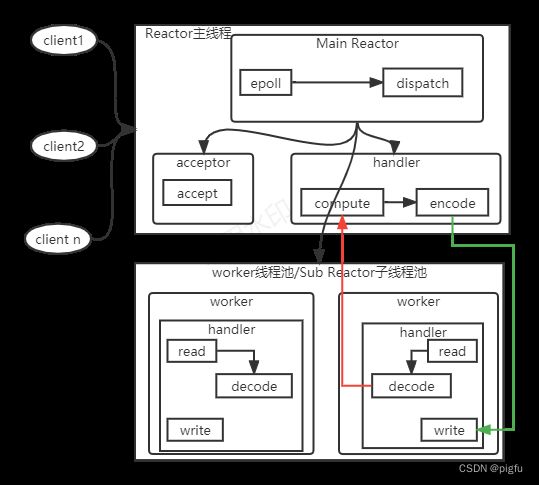
相比经典的主从Reactor多线程差距一目了然:
1)从rector和worker的线程池是同一个,这个倒是影响不大;
2)handler的任务做了重新安排,特别是业务处理的compute、encode由Reactor主线程处理,这个是迥异与经典主从Reactor多线程的。
3.2、命令执行过程
- Redis 服务器启动,注册 connAcceptHandler 连接应答处理器到用户配置的监听端口对应的文件描述符,等待新连接到来,最后通过aeMain开启主线程事件循环(Event Loop);
- 客户端和服务端建立网络连接;
- acceptTcpHandler 被调用,主线程使用 aeCreateFileEvent 将 readQueryFromClient 命令读取处理器绑定到新连接对应的文件描述符上,并初始化一个 client 绑定这个客户端连接;
- 客户端发送请求命令,触发读就绪事件,主线程不会通过 socket 去读取客户端的请求命令,而是先将 client 放入一个 LIFO 队列 server.clients_pending_read;
- 在事件循环(Event Loop)中,主线程执行 beforeSleep -->handleClientsWithPendingReadsUsingThreads,利用 Round-Robin 轮询负载均衡策略,把 server.clients_pending_read队列中的连接均匀地分配给 worker线程各自的本地 FIFO 任务队列 io_threads_list[id] 和主线程自己,worker线程通过 socket 读取客户端的请求命令,存入 client->querybuf 并解析第一个命令,但不执行命令,主线程忙轮询,等待所有 I/O 线程完成读取任务;
- 主线程和所有worker 线程都完成了读取任务,主线程结束忙轮询,遍历 server.clients_pending_read 队列,执行所有客户端连接的请求命令,先调用 processCommandAndResetClient 执行第一条已经解析好的命令,然后调用 processInputBuffer 解析并执行客户端连接的所有命令,在其中使用 processInlineBuffer 或者 processMultibulkBuffer 根据 Redis 协议解析命令,最后调用 processCommand 执行命令;
- 根据请求命令的类型(SET, GET, DEL, EXEC 等),分配相应的命令执行器去执行,最后调用 addReply 函数族的一系列函数将响应数据写入到对应 client 的写出缓冲区:client->buf 或者 client->reply ,client->buf 是首选的写出缓冲区,固定大小 16KB,一般来说可以缓冲足够多的响应数据,但是如果客户端在时间窗口内需要响应的数据非常大,那么则会自动切换到 client->reply 链表上去,使用链表理论上能够保存无限大的数据(受限于机器的物理内存),最后把 client 添加进一个 LIFO 队列 server.clients_pending_write;
- 在事件循环(Event Loop)中,主线程执行 beforeSleep --> handleClientsWithPendingWritesUsingThreads,利用 Round-Robin 轮询负载均衡策略,把 server.clients_pending_write 队列中的连接均匀地分配给worker 线程各自的本地 FIFO 任务队列 io_threads_list[id] 和主线程自己,I/O 线程通过调用 writeToClient 把 client 的写出缓冲区里的数据回写到客户端,主线程忙轮询,等待所有 I/O 线程完成写出任务;
- 主线程和所有 worker 线程都完成了写出任务, 主线程结束忙轮询,遍历 server.clients_pending_write 队列,如果 client 的写出缓冲区还有数据遗留,则注册 sendReplyToClient 到该连接的写就绪事件,等待客户端可写时在事件循环中再继续回写残余的响应数据。
Redis主线程和worker线程协作时序图如下:
